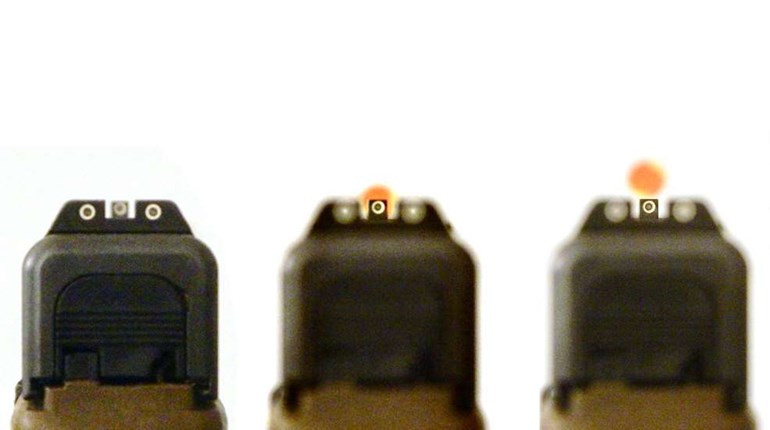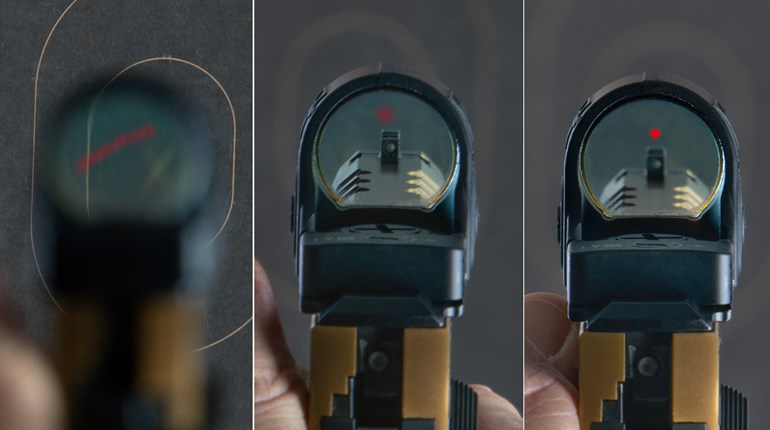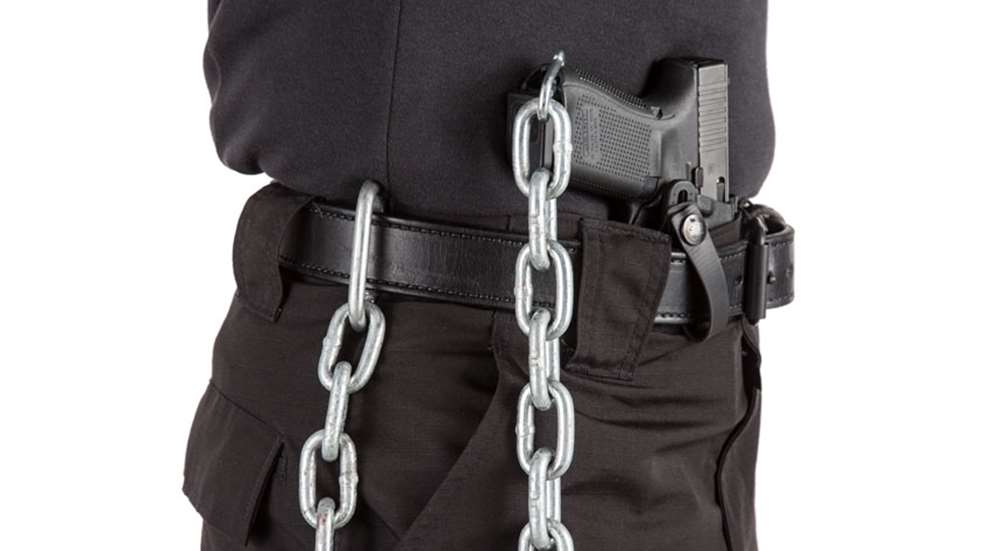
As an armed citizen, what can you do to keep from being disarmed in a violent physical altercation? In defensive carry there are many considerations when training to fight with a handgun, most commonly being rapid deployment and marksmanship. The less common, but equally important, are the dynamics of retaining your firearm in a fight at extreme close quarters, also known as weapon retention.
If you choose to carry for personal security, it is incumbent upon you not to be divested of your weapon. Regardless of where or how you may carry, IWB or OWB, the requisite skill set to protect a handgun from being taken away from you in a real-world altercation, should include weapon retention while in the holster, during presentation and when engaging a threat.
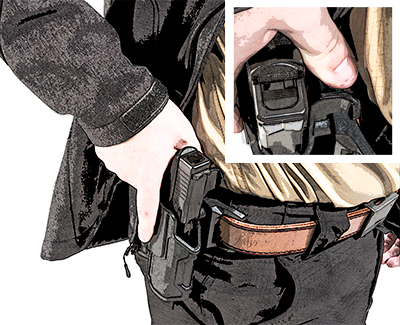
In the Holster
Starting with your handgun in the holster, your first weapon-retention consideration is mechanical. Carrying concealed may result in long periods of time with a firearm attached to your body. Therefore, it’s important to find a holster that comfortably fits your body type both safely and securely.
A safe holster completely covers the trigger guard, preventing unintentional trigger movement. A quality holster must also be firmly attached to your body in such a manner that it will not detach during routine daily activities or more rigorous physical demands such as running, climbing or fighting. Having a holster with your gun in it fall off your body, especially when you need it most, is less than optimal.
The advantages of carrying concealed are the element of surprise, immediate access and rapid deployment of a life-saving tool, if needed, to stop a threat. The disadvantages are that it must remain inconspicuous and avoid “printing,” which may be considered brandishing in some states.
Another mechanical consideration is retention devices. Working a bail, thumb or finger release must be part of your regular training regimen to effortlessly defeat whatever retention devices may be part of your carry holster during deployment.
An equally important consideration while in the holster is non-mechanical. Firearm retention starts in the holster by applying your situational awareness to your immediate environment. Awareness is the currency that buys you time. The sooner you can hear, see or smell a potential threat, the more time you are afforded to solve the tactical problem.
Bad guys always bring the initiative to the fight as they determine when, who and how they will attack, with what weapon(s) and what their intentions may be. As such, you are behind the action/reaction power curve and must take that initiative by making him, or them, react to you.
You can make them react to you by detecting early warning signs or threat indicators. By placing your attention on your immediate environment and scanning outward, you can effectively establish concentric rings of visual protection from near to far.
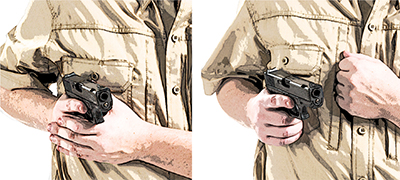
During Presentation
Worst-case scenario is dropping your gun, having it ripped out of your hands by an adversary or by bumping into something on your way out of the holster.
Typically, most gunfights occur at less than 10 yards, so there is very little distance to start with, translating into little reaction time. After clearing your cover garment and defeating any retention device(s), you are then tasked with purchasing a positive grip. Given the dynamics of rapid deployment with a narrow reaction-time window, you will most likely have no time to reacquire or adjust your grip during presentation or subsequent firing sequence if the situation requires a shooting solution.
An inadequate grip also lends itself to poor stability, which compromises both the integrity of the shot and your ability to retain the weapon against an adversary trying to wrest it away from you.
Creating space between yourself and the threat should be part of your presentation. More space equals more time and opportunity to solve the tactical problem. The converse of this is also true, less space equals less time and opportunity to solve the tactical problem.
Distance is your friend. However, if you cannot safely create distance, then at least change your physical position relative to the threat. Moving off the “x” becomes your highest priority. Move behind them, next to them, anywhere off that fateful “x” and away from a direct attack. The longer you stand on that “x” the more time and opportunity you allow the bad guy(s) to yank that pistol from your hands.
If you carry, you are the one bringing a gun to the fight and as such are responsible for maintaining possession. Staying mobile by changing your distance and or position makes you a significantly more difficult target for a weapon takeaway. As a moving target, you are always more difficult to catch.
Engaging a Threat
Once your weapon has cleared the holster, there are two firing positions that may be attained following presentation of the gun—retention position and extended position.
Exigent circumstances may require effective combat round placement as quickly as possible to stop the threat. Remember you are already behind the power curve, so you can’t afford to add even another tenth of a second to your already diminished action-reaction timeline.
Under duress, you don’t have time for much else other than clear your cover garment, defeat any holster-retention devices, build a positive grip, draw the weapon from the holster, align your muzzle with the threat and deliver an initial round downrange with your strong-hand-only.
The greater the urgency, the less time you have to even add your support hand to the grip. In this example you are afforded only one hand on your weapon and that is called the Strong-Hand-Only Retention Position.
Strong-Hand-Only
Since the earliest use of pistols, they were designed for strong-hand-only. Look up any historical woodcarving or painting from as far back as the mid-16th century of persons utilizing a pistol and you will find the shooters illustrated using only their strong hand. It remained that way through to the beginning of the 20th century. Shooting strong hand from the hip or unsighted fire can be traced to horseback. You can even find black-and-white photos of FBI agents in training shooting strong-hand-only from the hip up through the late 1960s. Cowboy Action shooting, point shooters, et al. practice this to date.
Due to the nature of a close-quarter altercation, extending the weapon away from your body, either from the hip or otherwise, places the weapon closer to your opponent. Being unsupported makes it an inviting target for disarming.
Retention Position
In modern retention, you want to keep your gun as far away from your attacker(s) as possible while maintaining a good firing position. You can accomplish this by drawing the handgun closer to your body and further connecting the pistol to your body using control points.
In contact there is control and in space there is escape. The more places the weapon arm contacts your body, the greater your control. Using control points results not only in better control and round placement, but the ability to retain possession of your weapon in personal combat.
The three control points are your wrist, biceps and elbow. Your strong-hand-only grip must be firm and tighter than when you shoot with both hands. Your wrist should be tight and high up on your torso as to gain the support of your biceps and forearm against your body. Your strong-side elbow should be pointing 180 degrees from the direction you want rounds to impact.
In addition to the above, your sights should be canted outbound, away from your body, so as not to allow the slide to strike or rub against the torso during cycling, impeding the functioning of the handgun.
Another option is to engage your support hand in addition to all the above to further lock the weapon into retention position. Applying your support hand to strong-hand-only retention position increases muzzle stability providing additional physical security, which significantly increases the difficulty for an opponent trying to remove it from you.
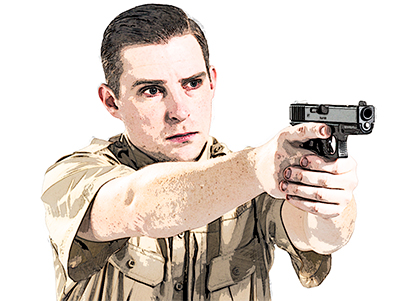
Extended Position
Although the fight may have started out at a far enough distance for you to use both hands extended, sighted or unsighted fire, the assailant(s) may have closed that reactionary gap so quickly during the struggle that they’re now at bad-breath distance—close enough where they may readily get a hand on your extended firearm.
Your attacker(s) may have even absorbed multiple rounds. Given a lead sponge coming straight for you at full force and knowing they’ve already lost the fight, they will give up their last remaining breath to try to rip that gun from your grip and use it against you.
To solve the rapidly diminished reactionary time problem, you are offered three defensive tactics:
1. Pull your handgun back into retention position.
2. Step back with your firearm still extended.
3. Step back and pull the gun into retention position.
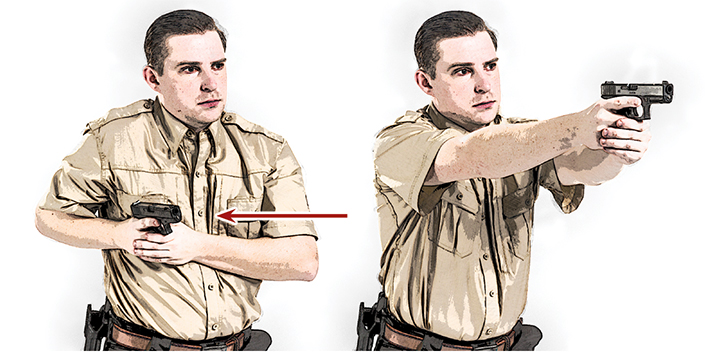
Pull Back
Pulling your pistol back away from the threat and into a retention position—with or without your support hand involved—buys you two advantages: One is that you create additional space, which buys you more opportunity and time to solve the tactical problem. The second is that you have brought the handgun to a position of mechanical advantage.
The mechanical advantage of the weapon-retention position allows you to bear the battle using your body’s core, whereas your opponent must extend his arms away from his core, which is the weaker, less advantageous physical position.
If you had to open a pickle jar with a tight lid, would you hold it far away from your body or in close to take advantage of it being in a better position to accomplish the task closer to your core?
A simple experiment you can run to demonstrate this concept is using a short broomstick, dowel or plunger handle. Hold the stick out away from your body as far as you can with both hands and have someone try and take it away from you.
After trying, ask your training partner to release their grip and this time you hold on to it tightly against your body closer to your core, with optimal support, both hands connected, up high on your torso and with multiple points of contact. Once you’ve established a death-grip on the stick, at your core and in retention position using both hands, ask your role player to try and remove it from your hold. After running this experiment, ask them which was the more difficult task—to remove the stick from extended position or from retention position.
Step Back
An alternative to switching from extended to retention position is changing your physical position. Use your legs to create distance, change distance and position as you continue moving off the “x.”
Remember, a moving target is much more difficult to acquire than a stationary one. If you’re constantly moving, you become a more difficult mark, and all the while you’re continuing to stop the threat with delivery of multiple rounds.
While he’s trying to figure out how to reach you and take your gun away, you’re working on your magazine change.
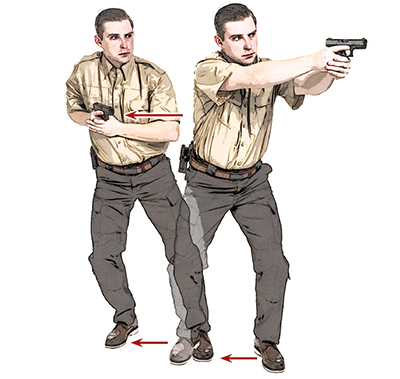
Step Back Plus Retention
Time permitting, the best of the three defensive tactics is to combine the pull back with the step back. Simultaneously changing your physical position, increasing your distance and moving your handgun to supported retention position does not impact your ability to shoot and makes disarming your pistol an exponentially more difficult task.
The best way to develop this skill is to first become familiar with each position in dry-fire and, when you feel comfortable, try each of these defensive tactics at the range live fire. Work all three firing positions. Try each separately. Fire from retention position strong-hand-only, both hands at retention position and then from both hands extended moving away from the target into retention position while firing.
Note your round placement. Note your hand position and get accustomed to what it feels like to fire rounds downrange using those three tactics.
You may even try layering more complex shooting skills into these by starting stationary and then add body movement. Remember to build stability starting with your grip and bring that stability to alignment.
Practice these at a comfortable speed where you can guarantee your hits and then start to push the envelope until the wheels fall off. Find the edge of your skill set envelope and know exactly what you can and can’t do by measuring your speed and accuracy in live fire.
Firearm retention is a matter of personal choice. You can choose to control your immediate environment using your situational awareness. You can choose the quality of your gear. You can choose your holster positioned as to promote optimal retention. You can choose which presentation to include strong-hand-only or strong-hand-supported retention, or extended position.
Ultimately, you can choose to develop the skills needed to keep from being disarmed in a violent physical altercation at extreme close quarters or decide that these skills are not all that important because “it will never happen to me.”












